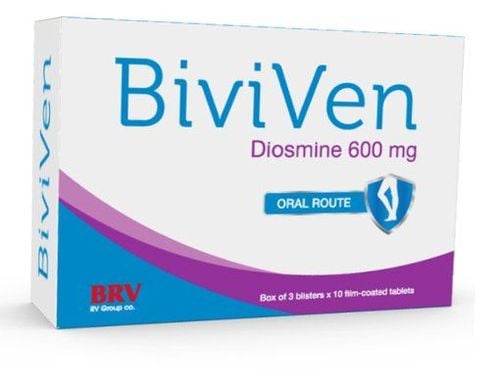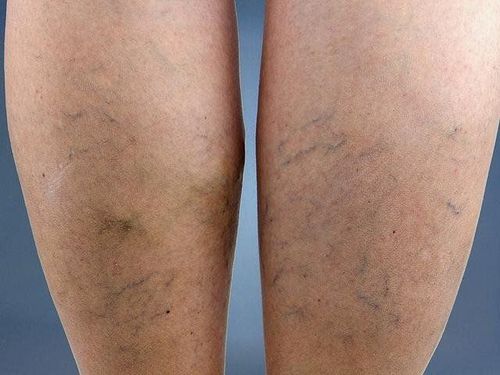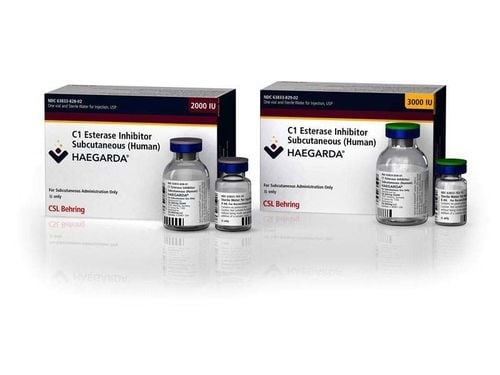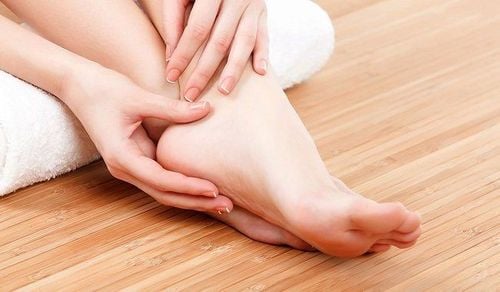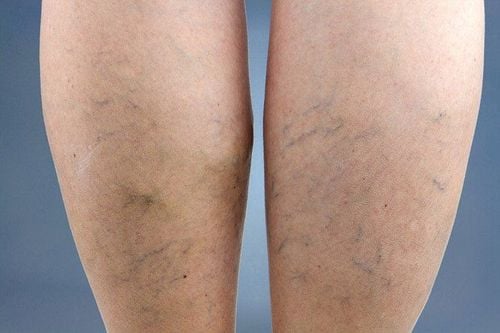This is an automatically translated article.
The article was written by the Doctor of Rehabilitation - Department of General Surgery & Anesthesia - Vinmec Hai Phong International General HospitalVenous insufficiency of the legs is a common disease and is expected to increase due to many factors. The disease can seriously affect the patient's health as well as greatly affect the country's economy. The following article will help you better understand this disease and its risk factors, from which there are simple and effective methods of treatment and prevention of varicose veins of the lower extremities.
1. What is leg vein insufficiency?
The veins in the legs carry blood back to the heart, they have a one-way valve to prevent blood from flowing back. Chronic venous insufficiency is a condition in which the valves do not work as they should and some of the blood can flow back down the leg. This long-term condition causes a decline in the function of the veins of the lower extremities, causing blood to stagnate in the veins, causing hemodynamic changes and deformation of surrounding tissues, creating symptoms such as fatigue, heaviness. Leg swelling, foot edema, paresthesia, ants... It can even lead to intractable and dangerous complications such as eczema, non-healing leg ulcers (especially in the elderly), bleeding, phlebitis superficial thrombosis, deep vein thrombosis, ... affect quality of life.
The cause of this condition is currently unknown but there are several risk factors that can cause damage to the one-way valves of the peripheral venous system such as:
A blood clot in the vein deep veins in the legs (called deep vein thrombosis) can damage valves Age-related degenerative process (over 50 years old) Gender: women are more likely than men Due to living and working positions have to stand or sit for a long time, be sedentary, have to carry heavy loads, work in a humid environment... Obese Pregnant or have been pregnant many times Family has a history of leg vein failure Person Have a history of blood clots Smoking
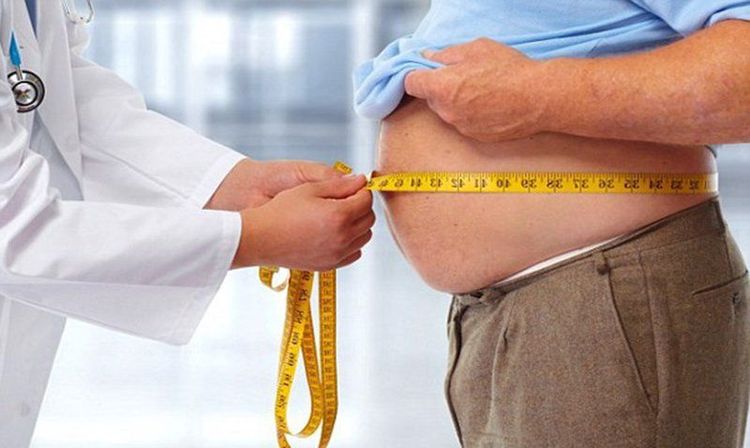
Người béo phì thuộc đối tượng có yếu tố nguy cơ mắc bệnh lý suy van tĩnh mạch chân
2. Exercises for patients with venous insufficiency of the legs
Regular exercise can alleviate varicose veins, reduce some symptoms and prevent complications from venous valve failure. Below is a guide to exercises for rehabilitation treatment of venous insufficiency in the lower extremities. Exercises need to be done regularly, gently, with full range of motion, not in a hurry and need to breathe evenly while practicing.
2.1. Exercises in the lying position 2.1.1. Ankle flexion and extension The patient lies on his back on a bed or exercise table, legs straight, lift left leg about 30 to 50 degrees off the bed, then practice ankle joint extension, then ankle flexion to the maximum extent. 10 to 15 times. Bring the left leg back to the starting position, and do the same for the right leg. Practice 2 to 3 times a day.
2.1.2. Rotate the ankle The patient lies on his back on a bed or exercise table, legs straight, raise the left leg off the bed about 30 to 50 degrees, then practice rotating the ankle joint from right to left and then from left to right 10 to 15 time. Bring the left leg back to the starting position and then do the same with the right leg. Practice 2 to 3 times a day.
2.1.3. Cross-legged The patient lies supine on a bed or exercise table, legs extended, then lifts both legs off the bed and exercises to cross the left leg over the right leg and then the right leg over the left leg alternately 10 to 15 times. Then bring your legs back to their original position on the bed. Practice 2 to 3 times a day.
2.1.4. Bicycling Patient lies supine on a bed or exercise table, lifts legs off bed, flexes hip and knee, and then performs 10 to 15 reps on a bicycle with both legs. Then bring your legs back to their original position on the bed. Practice 2 to 3 times a day.
2.2. Exercises in sitting position 2.2.1. Leg lift The practitioner sits on a chair of suitable height so that the feet are close to the floor, the ankle joint, knee joint, and hip joint are perpendicular; straight back; Body weight is evenly distributed on both buttocks and legs. Then alternately lift the right foot off the floor, straighten the right leg, then bring the right leg back to the starting position, do the same with the left leg, 10 to 15 times each, then do both. such legs. Practice 2 to 3 times a day.

Nâng cẳng chân
2.2.2. Heel tip The practitioner sits on a chair with the appropriate height as in the exercise above and then does the heel tip exercise (lift the leg until the ankle joint is straightened, only the tips of the toes are close to the floor, and then return to the floor). return to starting position) alternate left foot then right foot, then both legs at the same time, doing 10 to 15 repetitions. Practice 2 to 3 times a day.

Nhón gót chân
2.2.3. Ankle flexion and extension The practitioner sits on a chair as above, then lifts his left leg off the floor, straightens and then exercises to flex and extend the left ankle joint to the maximum (full range of motion) 10 to 15 times later Then bring the left leg back to the original position, continue doing the same for the right leg 10 to 15 times. Practice 2 to 3 times a day.

Gấp và duỗi khớp cổ chân
2.2.4. Ankle rotation The practitioner sits on a chair, feet are placed on the floor about 20cm apart, then lift the toes of the right foot off the floor with only the heel close to the floor, and then practice turning the ankle joint inward, out 10 to 15 times, then do the same for the left leg and both legs. Practice 2 to 3 times a day.

Xoay khớp cổ chân
2.2.5. Bend and stretch the legs alternately The practitioner sits in a chair, feet are placed on the floor, then practice stepping with the left foot forward, placing the left heel on the floor, then raising the right foot so that the right toe is close to the floor. , then move the left foot back, place the left toe close to the floor, step the right foot forward, the right heel close to the floor alternately 10 to 15 times for each leg. Practice 2 to 3 times a day.
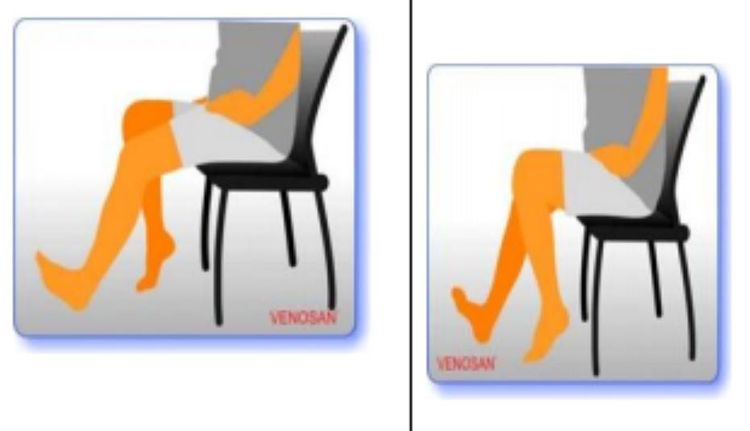
Gấp, duỗi luân phiên hai chân
2.2.6. Flexing and extending the combined leg joints The practitioner sits on a chair and then alternately lifts each leg off the floor, flexes the ankle, knee, and hip joints, then straightens that leg, bringing it back to the original position, Continue doing this 10 to 15 times, do the same with the other leg. Practice 2 to 3 times a day.

Gấp, duỗi luân phiên hai chân
If you have to sit for a long time, from 30 minutes to 1 hour you should do the exercises 1 time
2.3. Exercises in standing position 2.3.1. Ankle flexion and extension The patient stands, lifts one leg off the floor, and then exercises to flex and extend the ankle joint to a maximum of 10 to 15 times. Stand back to the starting position, lift the other foot off the floor and perform the same exercises with the leg did. Exercise 2 to 3 times a day
2.3.2. Ankle rotation The patient stands, lifts one leg off the floor, straightens that leg, and then exercises to rotate the ankle joint from the inside out and then from the outside in for 10 to 15 times, then return the foot to the original position on the floor. the floor and continue doing the same with the other leg. Exercise 2 to 3 times a week.
2.3.3. Elevate the foot in place The patient then stands and then practices walking in place for 15 to 20 steps by making the steps higher than usual. Practice 2 to 3 times a day.
2.3.4. Sit down and stand on tiptoe. Patient standing upright can lean on something nearby for support if needed, then sit down as if half squatting, then straighten up again, then tiptoe to stand. on the tips of your toes, and then sit down and repeat 10 to 15 times. Exercise 2 to 3 times a day
2.3.5. Toe-walking Patient stands upright, then lifts heels to stand on tiptoe, then takes about 15 to 20 steps on tiptoe (toe-walking). Practice 2 to 3 times a day.
2.3.6. Heel walking Patients with venous insufficiency of the lower extremities stand upright, then raise the toes to stand on both heels, and then walk about 15 to 20 steps on the heels. Practice 2 to 3 times a day like this
If you have to stand for a long time from 30 minutes to 1 hour, you should do the above exercises 1 time
2.4. Other exercises In addition to the above exercises, forms of exercise such as swimming, walking, brisk walking, jogging, aerobics, dancing, are also very good for health as well as good for the vascular system.
3. Tips and ways to prevent leg vein insufficiency
3.1. Diet People with varicose veins of the legs should ensure that their daily diet is full of nutrients, rich in vitamins and minerals, and has enough fiber such as fresh fruits, vegetables, whole grains... and limit eating a lot of fat to avoid constipation ; Should not be obese, if overweight and obese need to lose weight. Without maintaining a healthy weight, too much fat in your body also reduces blood flow.
In addition, make sure to drink enough water every day (from 1.5-2 liters of water a day).

Uống nước đầy đủ giúp phòng ngừa bệnh suy van tĩnh mạch chân
3.2. Lifestyle mode Clothes: should not wear tight clothes, especially tight tight pants in the pelvis, hips, and legs. Shoes: should wear shoes with soft soles and medium low heels (about 3-4cm), should not wear high heels, should walk naturally so that the weight is evenly distributed on both feet. Lying, sitting in the correct posture: When lying down, you should put your feet up 15-20cm above the level of the heart to facilitate blood flow to the heart through the veins. The seat has the right height so that when sitting, the feet are close to the floor, the ankle joints, knee joints, and hip joints are perpendicular; straight back; body weight evenly on both sides of the buttocks and legs; Do not sit and swing your legs, the underside of the thigh has just touched the seat surface to minimize the pressure on the underside of the thigh, not to obstruct the venous blood circulation running along the back of the thigh; It is necessary to avoid sitting positions that interfere with leg vein blood circulation such as squatting, sitting cross-legged. .. Patients with venous insufficiency of the legs need to give up a sedentary lifestyle and must develop a habit of exertion. Walk often, use the stairs instead of taking the elevator if possible to have more opportunities to exercise your veins, if you have to stand a lot, sometimes run in place to reduce the load on the venous system. Avoid carrying and carrying heavy loads because it will cause more blood to pool in the legs and make the veins more overloaded.
Exercise and sports: You should exercise regularly, you can practice and play sports with rhythmic and gentle movements such as walking, swimming, dancing bike... Do not play sports Sports with strong movements and sudden changes in direction that cause shock to the leg veins such as weightlifting, high jump, long jump, speed running, tennis, football... Exercise also helps maintain a full weight enough. Do not rub hot oil on your feet, do not soak your feet in hot water because the heat makes the veins dilate, reducing the ability to transport blood back to the heart. Do not take a bath that is too hot, after bathing, rinse your feet with cold water, cold water will constrict the veins to help blood flow to the heart more easily. And one more important thing, if you experience any uncomfortable symptoms in your legs such as pain or heaviness in your legs, swollen ankles or zigzag veins... If you travel every day, you should immediately go to reputable medical facilities with modern medical equipment and a team of highly qualified doctors for early examination and treatment advice to prevent complications. danger may occur.
Vinmec International General Hospital is the address for examination, treatment and prevention of diseases. When performing the examination process at Vinmec, customers will be welcomed and used modern facilities and equipment along with perfect medical services under the guidance and advice of experts. Good doctors, well-trained both at home and abroad.
Please dial HOTLINE for more information or register for an appointment HERE. Download MyVinmec app to make appointments faster and to manage your bookings easily.




